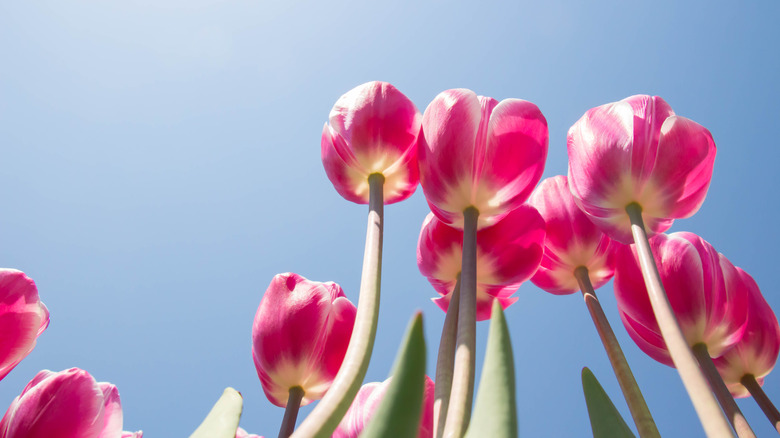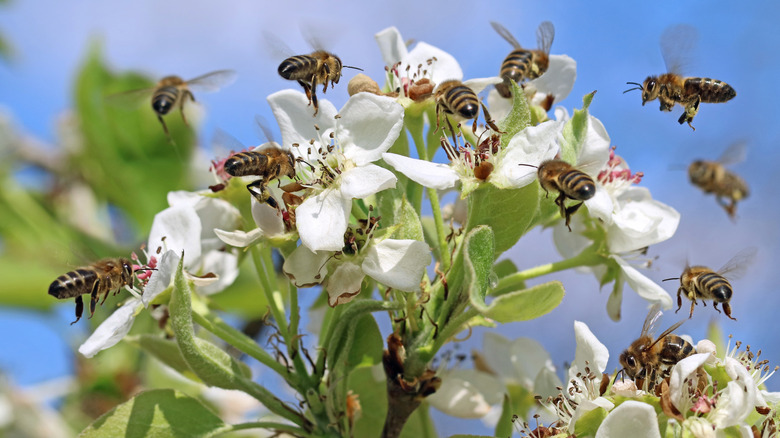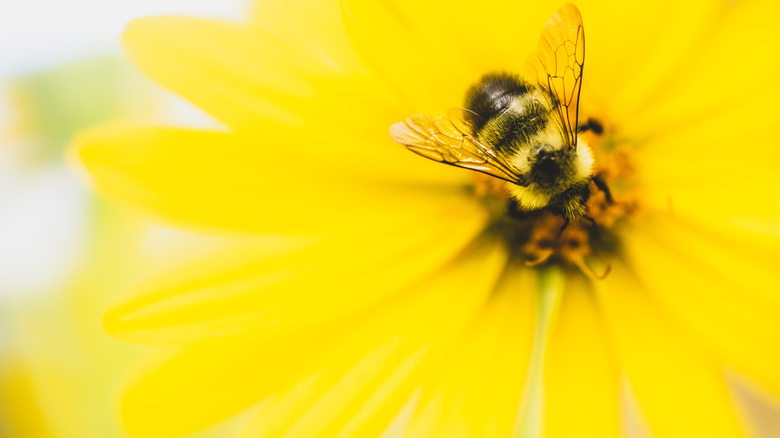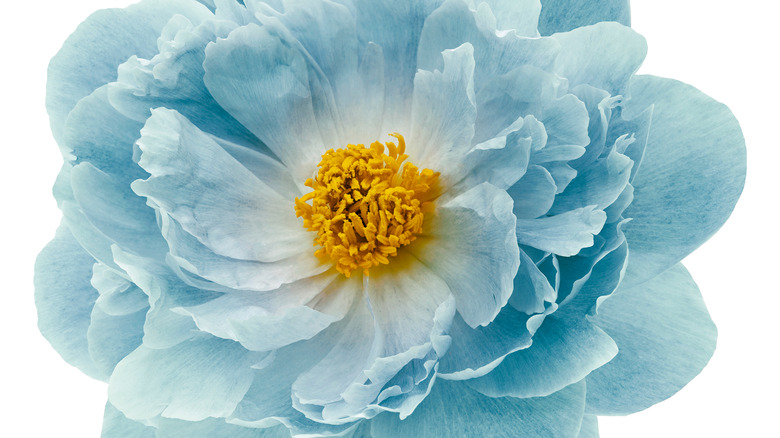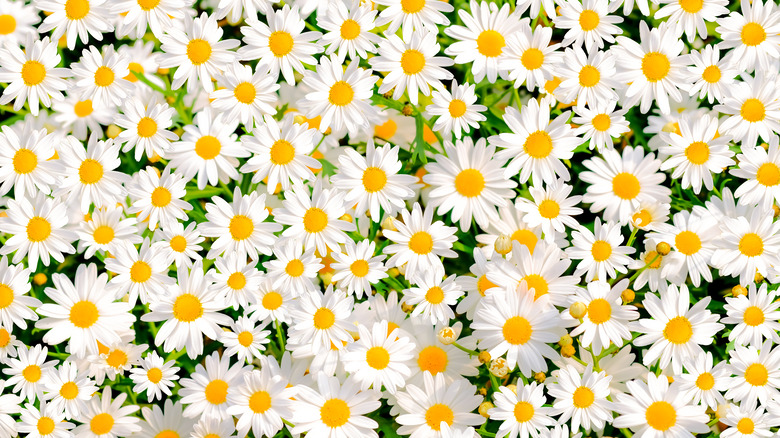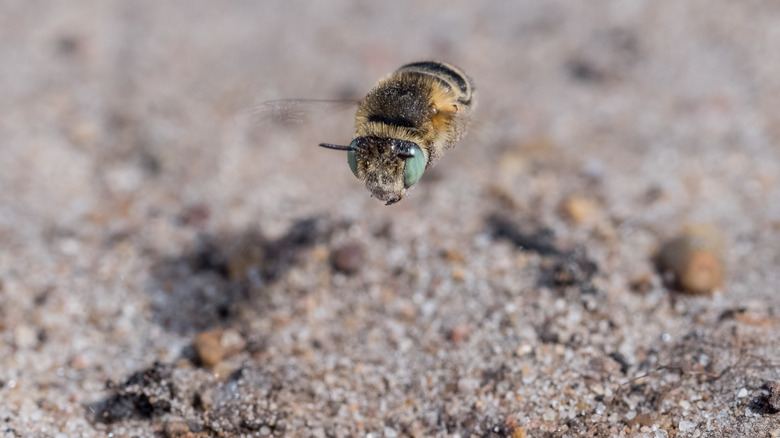The 'Blue Halo Effect' That Woos Pollinating Bees To Your Garden
Given the current global bee crisis, where bee populations have dwindled dramatically due to manicured lawns, pesticides, and lack of wildflower meadows, gardeners are doing what they can to help. The ways to contribute are endless. They range from planting pollinator gardens to simply laying off the mulch. In some cases, just going easy on weeds does the trick. The bee shortage is dire, so any action that can improve the situation is worth considering.
While gardeners are doing their part to help, researchers have been uncovering little-known strange ways that flowers can woo the bees as well. Yes, we knew certain flower colors attract bees. We also had an idea that certain scents made a difference. What scientists are now uncovering is that there is an ultraviolet spectrum resulting from sunlight reflecting on petals that creates a veritable blue halo. Sound phony? Not according to the Daily Maverick and several researchers at the Adolphe Merkle Institue in Fribourg, Switzerland, as well as Cambridge University. Essentially, we can't see it, but bees can.
Why do bees matter?
Bees are responsible for pollinating about 70% of the crops that feed 90% of the world, according to the BBC. However, NPR reported that we lost around 40% of our honeybee colonies in 2020, a number that is historically about 10%. Those numbers are alarming, and, unfortunately, the trend continues. Diminishing bee numbers at that scale means they're pollinating fewer plants. Less of those plants will lead to a food shortage for the animals eating those plants. Add all that up, and you might find that the grocery store has half its current fruits and vegetables, breaking the back of a system trying to maintain a food supply for a worldwide population of 8 billion people.
If you ever wanted to make a global and political impact starting from your backyard (literally), helping the bees is a way to do that. More accurately, you can help the bees, help us. Bees and other pollinators are unequivocally capable of managing the job at hand. Wonderopolis reports that a single bee can pollinate 5,000 flowers daily. That sounds like a lot, but a pound of honey calls for a hive to hit almost 2 million flowers. It's a colossal undertaking, of which bees are fully skilled and stacked to pull off — if we help them keep their troop numbers up.
What attracts pollinators?
Pollinators love colors, scents, and native plants. When gardeners are strategic with specific blooms that attract native pollinators, it makes a huge difference. One of the most unsung but important points to consider when pushing pollination is keeping native plants in your garden. This step makes a major difference in stabilizing a pollinator problem in your garden and community, says Florida Museum.
In their case, scientists asked locals to watch out for two plants that had once been prevalent (and pollinator essential) but were diminished by agriculture and urban development — the sundial lupine and wild indigo. The unintended catastrophic effect was that the frosted elfin butterfly (Callophrys irus), which foraged off those indigenous plants, became endangered. You can avoid inadvertently knocking out native plants or planting non-natives by checking your local nursery plant providers. Another resource to check is the North American Native Plant Society.
What part does 'blue halo effect' play?
Blue flowers have long been known to attract bees thanks to the extra nectar they pump out, says Science. However, a blue flower is tough to come by — in nature or the lab. Horticulturalists looking to boost pollination have been trying to tweak red and pink blooms by borrowing certain pigments and turning them into something blue (though the flowers usually wind up purple, according to The Atlantic). Scientists have only recently discovered that many flowers have a blue tinge, akin to a halo at the base of their petals.
We might get lucky and see these blue wavelengths of light, but that's not likely. Beverley Glover, director of the Botanical Gardens at the University of Cambridge, happened upon the blue halo when she saw a blue shimmer on a white flower that had her on the case to find which flowers had this similar effect. She found an odd incidental related to petal ridges that created an optical iridescence that looked like a bluish tint.
The team called the variability among the petal ridges a "disorder." For gardeners, that "disorder" is another tool for accommodating pollinators doing the yeoman's labor to feed the world.
What flowers have the blue halo effect?
According to a recent Associated Press story on the blue halo, not every flower can pull off the iridescent light bounce trick. However, gardeners should consider stocking up on those flowers that can. Peonies are an excellent blue halo option, as are some tulips. The Evening primrose (Oenothera stricta) has a blue-to-ultraviolet halo, as does the Flower-of-the-hour (Hibiscus trionum).
Certain daisies also deliver the blue halo — an added enticement to bees that are already attracted to the daisy's flat landing pad, yellow tab middle, and nectar known to attract ladybugs and other good insects that snuff out pests. Daisies known to display the blue halo effect include daisies from the Ursinia speciosa variety, according to the University of Cambridge. For mere humans wanting to see the blue halo, your best bet is "Queen of the Night," a deep purple tulip variety. However, that blue iridescent "halo" mainly attracts bumblebees, which is fine by gardeners longing to leverage every pollinating-inducing strategy possible.
Any other ways to help pollinators?
At the end of the day, new scientific revelations on the evolution of flowers attracting bees are fun to know and helpful to deploy. With the U.S. Forest Service warning that 80% of modern plants around the world depend on pollination, gardeners are duty-bound to maximize every helpful tip to make the world a more inviting place for bees. What else can you do? Plenty.
For one thing, pollinator gardens that are set up with birds, bees, and butterflies in mind, rather than being neighborhood blue ribbon for most manicured, are great for helping fledgling bees who are longing for the old days of wildflower meadows. Even a small section of the yard or a couple of pots set on patios or outside apartment windows are helpful. Eco Landscaping encourages a cluster of plants with a variety of blooms that offer nectar from spring through fall.
Another idea is to use minimal mulch (or, frankly, no mulch at all), says Annapolis Native Landscape Design, since bees burrow in the bare spots of your garden for winter. Or consider letting the dead leaves, old blooms, and stalks from your dead foliage be your mulch. Natural garden detritus draws in beetles that get rid of cockroaches. With bare spots in your garden and the blue halo effect in your flowers, we just might turn this ecological trend aright.
